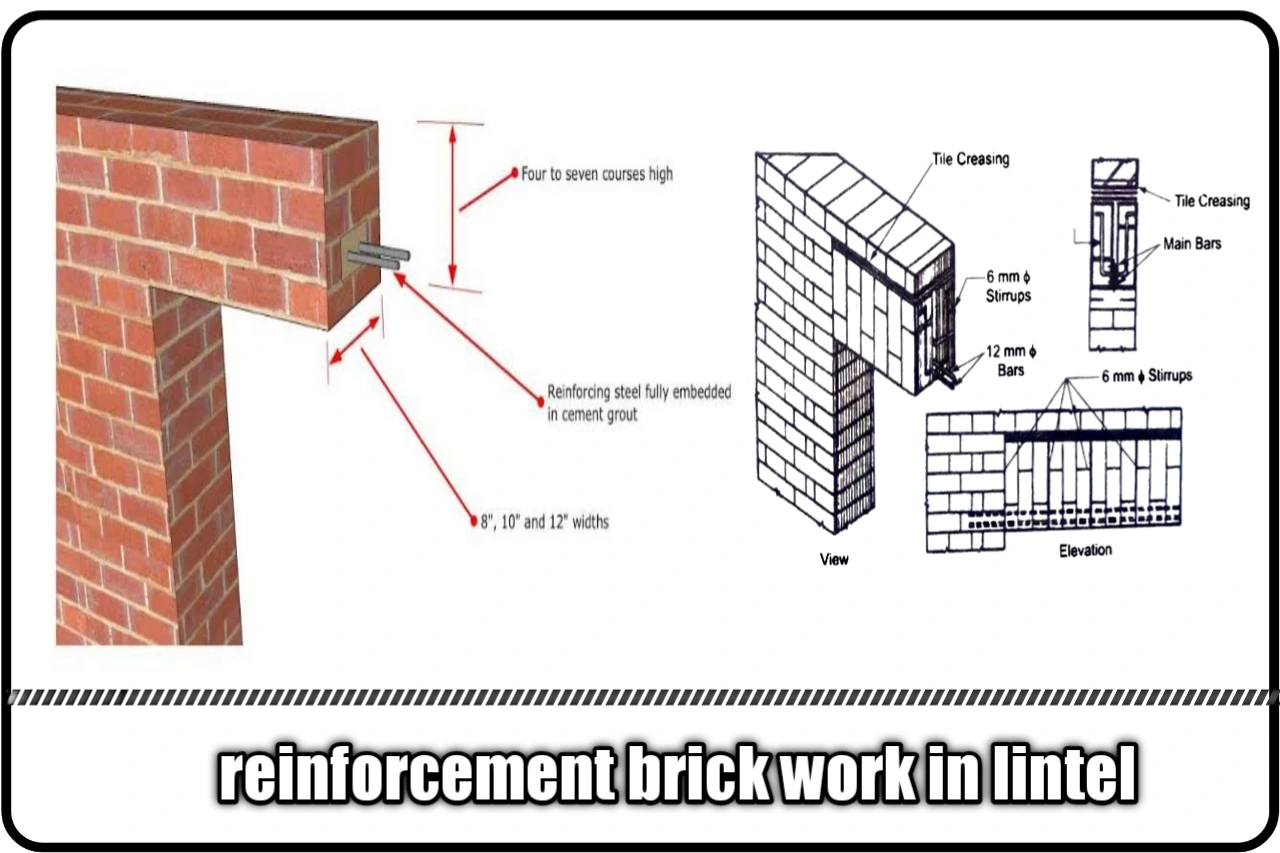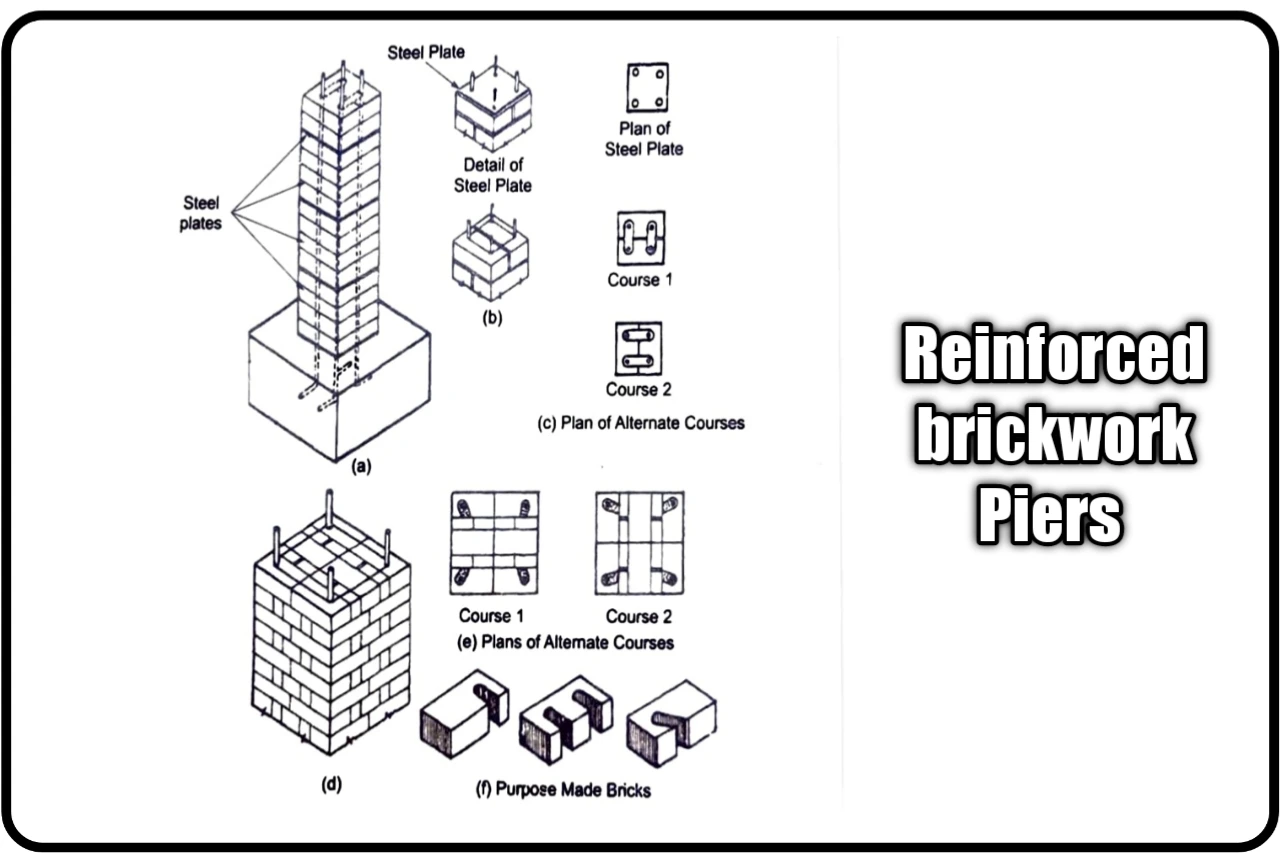Reinforced brickwork is the one in which the brick masonry is strengthened by the provision of mild
steel flats, hoop iron, expanded mesh, or bars. we will see reinforced brickwork in retaining walls, columns, lintels, and walls…
Why We Use Reinforced Brickwork ?
- When the brickwork has to bear tensile and shear stresses.
- When it is required to increase the longitudinal bond.
- When the brickwork is supported on soil that is susceptible to a large settlement.
- When the brickwork is supposed to act as a beam or lintel over openings.
- When the brickwork is to resist lateral loads such as in retaining walls etc.
- When the brick wall is to carry heavy compressive loads.
- When the brickwork is to be used in seismic areas since it can also resist lateral loads.
Reinforced brickwork uses first-class bricks with high compressive strength. Dense cement mortar
is used to embed the reinforcement.
Reinforcement For Reinforced Brickwork
Following are the reinforcement used for reinforced brickwork.
(i) Hoop iron
(ii) Mild steel bars
(iii) Mile steel flats
(iv) Expanded mesh
The reinforcement is laid either horizontally or vertically.
A) Horizontal Reinforcement
Horizontal reinforcement for wall consists of either
(1) Wrought iron flat bar. known as hoop iron
(2) Steel mesh
(3) Longitudinal reinforcement
(1) Hoop Iron
Hoop Iron shows the hoop iron reinforcement for a brick wall. Generally, two strips of hoop iron are used per header brick and one hoop iron per stretcher brick i.e. one strand of hoop iron for each half brick thickness of the wall. Mild steel flats may also be used in place of hoop iron. It is usual to reinforce every switch course. Mild steel flat bars may have a width between 22 to 32 mm and a thickness equal to 0.25 to 16 mm.

Protection against rust is provided by dipping the bars in hot tar; these are then at once sanded to increase the adhesion of the mortar. At the ends ( quoins ) the bars are beaten flat and then double hooked to bars coming from transverse direction. At the junctions, the bars crossing each other are interlaced and single hooked. Hoop iron is now rarely used because of its higher cost and because of its thickness unless thicker joints are used.
(2) Steel mesh
Another form of horizontal reinforcement, which is more commonly used, is the provision of steel mesh strips called Exmet made from their rolled steel plates which are cut and stretched ( or expanded) by a machine to the diamond network. Such a strip is known as expanded metal ( Exmet ) and is provided at every third course. These strips are available in widths of 65 mm, 178 mm, and 230 to 305 mm, with thicknesses of 0.6 mm, 0.8 mm, and 1 mm.

They are supplied in coils of 83 m in length. To prevent Corrosion, the metal in the coil form is coated with oil and then dipped in asphalt paint. Cement CO first trowelled on the bed and the Exmet is uncoiled and pressed down in the mortar.

Another meshed reinforcement called Bricktor is made of a number of straight tension wires (1.4 mm) interlaced with binding wires (1.1 mm). One such strip is provided for every half-brick thickness of the wall.
(3) Longitudinal reinforcement
Horizontal reinforcement is also used for brick lintels as shown in Fig. . Generally, mild steel bars (6 to 11mm) are provided through the vertical joint, all along the span of the lintel. If the lintels carry heavy loads, resulting in heavy shear force. 6 mm dia. steel wire stirrups are provided at every 3rd vertical joint, as shown in Fig. The longitudinal steel bars (main reinforcement) should extend 150 min beyond the jambs.


(B) Vertical Reinforcement
Vertical Reinforcement, in the form of mild steel bars, is provided in brick columns, brick walls brick retaining walls. In such circumstances, special bricks, with one or two holes extending up to the face, are used Vertical mild-steel bars are then placed in the holes.
(1) Reinforced brickwork in columns,piers
These bars are anchored by a steel plate or wire-tie at some suitable interval. below Fig. shows the details of reinforced back work piers

(2) Reinforced brickwork in retaining wall
Brick retaining walls are often reinforced since such a work is cheaper than the reinforced cement concrete when the height of the wall is up to 3 m (Fig.). Vertical reinforcing bars are placed vertically near each face, in addition to steel meshed strips at every fourth course.
The brick opposite each bar is purpose-made, having a groove. The size of the groove is kept slightly more than the diameter of the bar so that it may be grouted in with cement mortar, to prevent corrosion, Steel wire ties may be provided at every fourth course.

In all types of reinforced brickwork, it is essential to embed the steel reinforcement in rich cement mortar (usually 1 : 3). with a proper cover so that reinforcement is not corroded. Corrosion will result in an expansion of the joint and consequent cracking.
The bricks should also be of high quality, possessing high compressive strength so that optimum use is made of all the materials (i.e. bricks, mortar, and reinforcement).
I Hope You Like Our Article “What is Reinforced Brickwork? Types And Construction of Reinforced Brickwork” Don’t be Cheap To Share This Article with your Friends.
READ MORE
- How To Purchase Best TV Mounting? |2021|
- What Is Micro Concrete? Its Properties And Application |2021|
- Durability of Concrete, Factor Affecting Durability, And Its Requirement For Concrete |2021|
- How To Perform Valuation of Land And Property? |2021|
- What is Reinforced Brickwork? Types And Construction of Reinforced Brickwork |2021|

